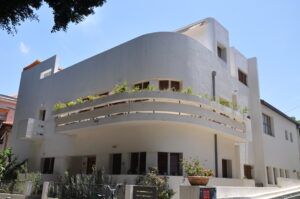The twentieth century saw the emergence of a wide array of artistic movements, ranging from small and local to broad and international. However, few have had such a significant and lasting impact on art as Bauhaus. Today, the Bauhaus influence can be seen all over the world, with the largest collection of Bauhaus architecture being located in the center of Tel Aviv, Israel.
What is Bauhaus?
Bauhaus originated as a German school of art, founded by Walter Gropius in 1919 in an effort to bring together all branches of art under one umbrella. The school taught a wide range of techniques, including (but not limited to) architecture, bookbinding, graphics and advertising, painting, metalworking, furniture design, sculpture, pottery and photography.
The Bauhaus School quickly gained international recognition for its unique aesthetic. The approach places a specific emphasis on function, balanced forms and abstract shapes, while straying from ornamentation. Bauhaus’s distinctive qualities have been described as being in the “international style,” as it heavily influenced the course of modern and contemporary art around the world.
The school originated in Weimar, Germany, but over time, two more locations popped up in Dessau and Berlin. Though each art form was of equal importance to the school, Dessau in particular became renowned for its focus on architecture.
Despite the fact that Gropius designed numerous buildings before starting the Bauhaus School, the architecture department was not opened until 1927 under the direction of Hannes Meyer. Here, Meyer trained a generation of world-famous architects, kick-starting an international architectural style.
The influence of Meyer’s teachings reached the entire globe, but it is specifically notable in Tel Aviv’s “White City.”
Bauhaus in Israel
As the Bauhaus School developed, it came to include and be guided by distinct political ideals. The majority of Bauhaus artists took on socialist and communist beliefs. On top of that, many students and instructors happened to be Jewish.
Thus, when the Nazi party rose to power in 1933, the school was forcefully disbanded, forcing thousands of artists to leave Germany. Among these was a group that fled to Mandatory Palestine, where its members would put to practice what they had learned in Europe.
Though Tel Aviv was founded in 1909, it did not become an urban center until about a decade later – during British rule. In 1925, the Tel Aviv municipality commissioned Sir Patrick Geddes of England to plan the layout of the city. His urban vision featured large green spaces and a heavy emphasis on transportation routes.
However, after the Nazi occupation in Germany and Austria forced tens of thousands of Jews to flee their homes, Tel Aviv’s population increased at a rate that Geddes had not foreseen. This sudden influx gave a major boost to the Israeli Bauhaus-trained architects, who spearheaded the creation of the “White City” that would go on to serve as the bustling center of Tel Aviv.
Related Reading: A Guide to Israel’s UNESCO World Heritage Sites
Notable Bauhaus Figures
Aside from Walter Gropius and Hannes Meyer, the students at the Bauhaus School had the opportunity to learn from world renowned artists.

Among such luminaries was , one of the best-known names in the modern art sphere. Before the founding of the Bauhaus School, Kandinsky famously established Der Blaue Reiter – the Blue Rider group that represented the German Expressionism movement.
With headlining teachers such as Kandinsky, students from all over the world aspired to learn from the masters at the Bauhaus School.
Arguably the most significant Israeli Bauhaus student was Arieh Sharon. Specifically drawn to the application of architecture, Sharon enrolled in the Bauhaus School at Dessau in 1926. There, he worked directly with Meyer, who eventually hired him full-time in his Berlin office.
Sharon’s tenure in Germany was short-lived, and by 1931 he had moved to Tel Aviv and opened his own architectural firm. Though he started out planning Kibbutzim, he ultimately played a major role in the development of Tel Aviv’s urban landscape.
By combining the ideas of Hannes Meyer and Sir Patrick Geddes, Sharon was revered by many as the father of Israeli architecture. His colleagues, especially Genia Averbuch and Ze’ev Rechter, aided him in the creation of the Tel Aviv buildings that ultimately resulted in the city being named a UNESCO World Heritage site in 2003.
Tel Aviv’s Bauhaus Center Today
With Arieh Sharon’s master plan for Tel Aviv, Israeli Bauhaus architects constructed over 4,000 buildings between 1920 and 1940, the majority of which are well-preserved. Though each building was created in its own style, they all feature typical elements of modernism, notably undecorated surfaces, flat roofs, and outdoor spaces.
Due to the large number of contributors to Tel Aviv’s architecture, the city is a fine representation of the wide range of artistic trends inspired by Bauhaus. However, Tel Aviv’s distinctive culture and ambience are apparent. In particular, the “White City” showcases the implementation of a European style that has been altered to accommodate Tel Aviv’s Mediterranean climate.
One such building is Ze’ev Rechter’s Soskin House. Built in 1933 for photographer Avraham Soskin, the structure is split into two asymmetrical wings. The front wing, meant to be a family home, showcases a flat roof, rows of windows and balconies accessorized with horizontal ventilation slits. The back, intended to be used as a studio, was designed to appear invisible to onlookers from the street.

Just down the road is Dizengoff Circle, the heart of Tel Aviv’s Bauhaus scene. Designed by Genia Averbuch in 1938, Dizengoff Circle is the only Bauhaus plaza in the world. Its simple yet elegant design is in line with the surrounding white buildings that are in the Bauhaus style. Thus, despite its heavy minimalism, Dizengoff Circle is viewed as one of the most important Bauhaus architectural constructs in existence.
While there are many Bauhaus structures in Tel Aviv, only about half of them are protected under preservation laws. In response, the Bauhaus Center Tel Aviv was established in 2000 to promote awareness of the Bauhaus heritage and to ensure the preservation of other buildings. Between the resources provided by the Center, as well as the architecture that can be seen just by walking down the streets, visitors to Tel Aviv can get an idea of what true Israeli Bauhaus style looks like.
Liked this article? Follow HonestReporting on Twitter, Facebook, Instagram and TikTok to see even more posts and videos debunking news bias and smears, as well as other content explaining what’s really going on in Israel and the region.
New! Skip the social scroll and get the latest from HonestReporting via Telegram.

